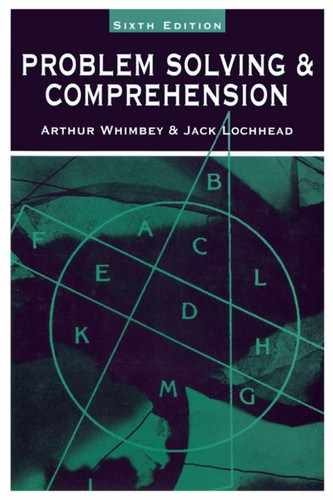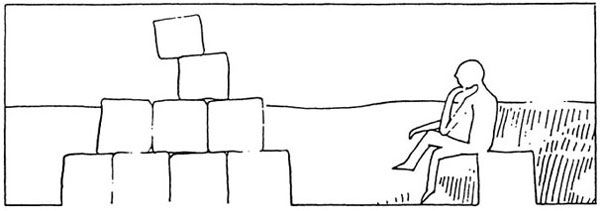
Introduction
In this chapter each problem is followed by a problem solution. Scan the solution to see if your answer is correct. If it is not correct, read the entire problem solution aloud. As you read the solution, notice how the problem is analyzed into steps. Also notice any diagrams or other problem-solving aids and techniques that are employed. Make use of these techniques whenever they are appropriate in solving later problems.
Problem 1
José is heavier than Fred but lighter than Marty. Write the names of the 3 men on the diagram below.
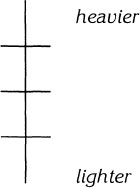
José is heavier than Fred but lighter than Marty. Write the names of the 3 men on the diagram below.
Problem Solution
Step 1. José is heavier than Fred … He would be placed above Fred on the diagram.

Step 2. … but lighter than Marty.
This says José is lighter than Marty. So Marty is placed above José on the diagram.

Jack is slower than Phil but faster than Val. Val is slower than Jack but faster than Pete. Write the names of the 4 men in order on the diagram below.
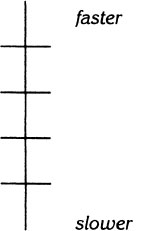
Jack is slower than Phil but faster than Val. Val is slower than Jack but faster than Pete. Write the names of the 4 men in order on the diagram below.
Problem Solution
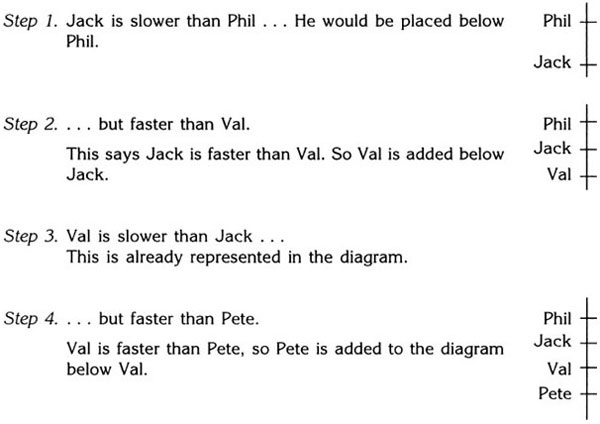
If Dumani and Fred are both richer than Tom, and Hal is poorer than Dumani but richer than Fred, which man is the poorest and which one is the next poorest? Write the names of all 4 men in order on the diagram.
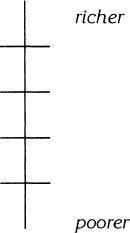
If Dumani and Fred are both richer than Tom, and Hal is poorer than Dumani but richer than Fred, which man is the poorest and which one is the next poorest? Write the names of all 4 men in order on the diagram.
Problem Solution
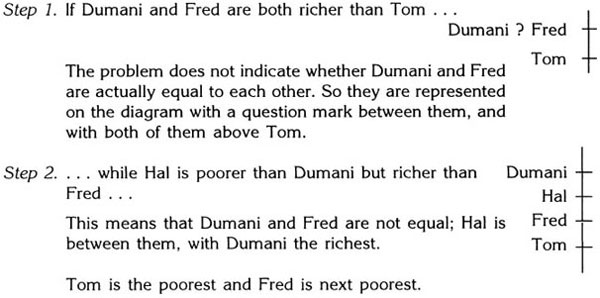
Paul and Tom are the same age. Paul is older than Cynthia. Cynthia is younger than Hal. Is Paul older or younger than Hal—or can this not be determined from the information?
Paul and Tom are the same age. Paul is older than Cynthia. Cynthia is younger than Hal. Is Paul older or younger than Hal—or can this not be determined from the information?
Problem Solution

Cathy knows French and Farci, Nomsa knows Xosha and Chinese, Cindy knows Spanish and French, and Parvati knows Farci and Xosha. If French is easier than Farci, Chinese is harder than Xosha, Farci is easier than Xosha, and Spanish is easier than French, which girl knows the most difficult languages?
Cathy knows French and Farci, Nomsa knows Xosha and Chinese, Cindy knows Spanish and French, and Parvati knows Farci and Xosha. If French is easier than Farci, Chinese is harder than Xosha, Farci is easier than Xosha, and Spanish is easier than French, which girl knows the most difficult languages?
Problem Solution
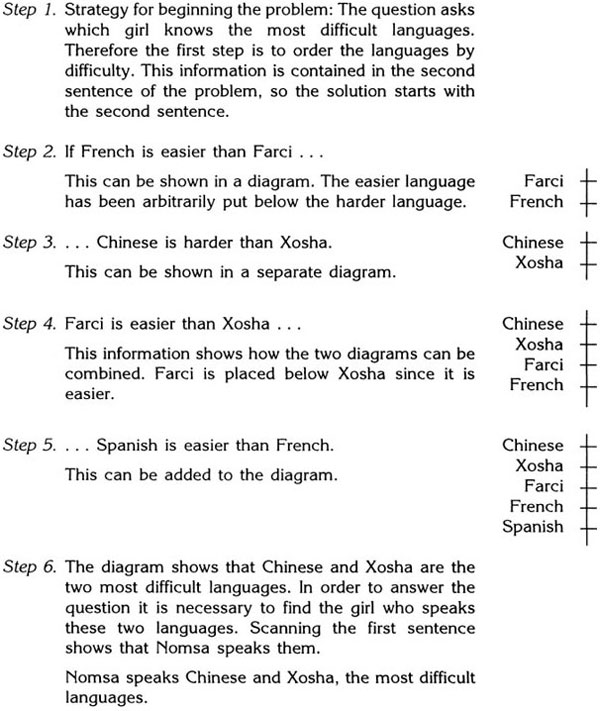
Hom, Sam, and Ricardo differ in height. Their last names are Smith, Su, and Calvin, but not necessarily in that order. Hom is taller than Ricardo but shorter than Sam. Smith is the tallest of the 3 and Calvin is the shortest. What are Hom’s and Ricardo’s last names?
Hom, Sam, and Ricardo differ in height. Their last names are Smith, Su, and Calvin, but not necessarily in that order. Hom is taller than Ricardo but shorter than Sam. Smith is the tallest of the 3 and Calvin is the shortest. What are Hom’s and Ricardo’s last names?
Problem Solution
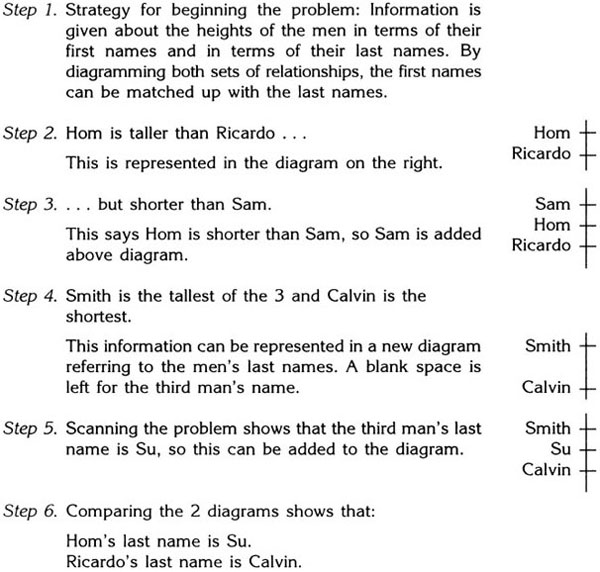
Three fathers—Pete, John, and Nick—have between them a total of 15 children of which 9 are boys. Pete has 3 girls and John has the same number of boys. John has 1 more child than Pete, who has 4 children. Nick has 4 more boys than girls and the same number of girls as Pete has boys. How many boys each do Nick and Pete have?
Hint: It may be helpful to arrange the information into a table of the type shown below.

Three fathers—Pete, John, and Nick—have between them a total of 15 children of which 9 are boys. Pete has 3 girls and John has the same number of boys. John has 1 more child than Pete who has 4 children. Mick has 4 more boys than girls and the same number of girls as Pete has boys. How many boys each do Nick and Pete have?
Problem Solution
Step 1. Three fathers—Pete, John, and Nick—have between them a total of 15 children of which 9 are boys.

Step 2. The table shows that there are 9 boys and a total of 15 children. So there must be 6 girls.

Step 3. Pete has 3 girls and John has the same number of boys.

Step 4. John has 1 more child than Pete who has 4 children. This means John has 5 children.

Step 5. The table shows that Pete has 4 children, of which 3 are girls, so he must have 1 boy. Also, John must have 2 girls; and Nick must have 6 children since Pete and John together have 9 children.

Step 6. Looking at the last table shows that Pete and John together have 4 boys, so Nick must have 5 boys. Also, Nick must have 1 girl.

Step 7. The table is filled in, but there is one sentence of information remaining. It can be read and checked against the table to make sure that the table is correct.
Nick has 4 more boys and the same number of girls as Pete has boys.
The table shows that Nick has 5 boys and 1 girl—so he does have 4 more boys than girls. The table is correct on this point. Also, Nick has 1 girl and Pete has 1 boy, so this is correct.
Step 8. How many boys each do Nick and Pete have?
The table shows: |
Nick has 5 boys. |
Pete has 1 boy. |
Paula, Joanne, and Mary own a total of 16 dogs, among which are 3 poodles, twice that many cocker spaniels, and the remainder German shepherds and collies. Joanne despises poodles and collies, but owns 4 cocker spaniels and 2 German shepherds, giving her a total of 6 dogs. Paula owns 1 poodle and only 2 other dogs, both German shepherds. Mary owns 3 collies and several other dogs. What other dogs (and how many of each) does Mary own?
Note: In constructing a table for this problem, remember to enter zeros as well as positive numbers whenever appropriate. Some students forget to enter zeros and therefore think this problem cannot be solved. Also, enter totals as soon as you can. For example, enter the total of 16 dogs now.
Paula, Joanne, and Mary own a total of 16 dogs, among which are poodles, twice that many cocker spaniels, and the remainder German shepherds and collies. Joanne despises poodles and collies, but owns 4 cocker spaniels and 2 German shepherds, giving her a total of 6 dogs. Paula owns 1 poodle and only 2 other dogs, both German shepherds. Mary owns 3 collies and several other dogs. What other dogs (and how many of each) does Mary own?
Problem Solution
Step 1. Paula, Joanne, and Mary own a total of 16 dogs, among which are 3 poodles, twice that many cocker spaniels and the remainder German shepherds and collies.

Step 2. Joanne despises poodles and collies, but owns 4 cocker spaniels and 2 German shepherds.

Step 3. Paula owns 1 poodle and only 2 other dogs, both German shepherds.

Step 4. Since Paula and Joanne own 9 dogs between them, and there are a total of 16 dogs, Mary must own 7 dogs. Also, since Paula and Joanne have only 1 poodle between them, Mary must own 2 poodles. Again, Mary must own 2 spaniels since Paula and Joanne have 4 between them. This is shown in the next table.

Step 5. Mary owns 3 collies and several other dogs.

Step 6. The table shows there are a total of 3 collies. Thus there must be 4 shepherds. This means that Mary owns no shepherds.

Step 7. What other dogs (and how many of each) does Mary own?
The table shows Mary owns 2 poodles and 2 cocker spaniels in addition to her collies.
Sales agents who work for the Acme Wig Company are assigned to a different city each year. Henry began working for Acme in New York in 1995, and in the succeeding 4 years worked in Minneapolis, New Haven, Youngstown, and Charleston, in that order. Martha worked for Acme in New Haven in 1993, and in succeeding years worked in New York, Charleston, Minneapolis, and Youngstown. Fred worked for Acme in Charleston in 1997; the previous 2 years he had worked first in New Haven and then in Minneapolis. John worked in Charleston in 1998. Before that he was in New Haven, before that Youngstown, and before that New York. Which Acme sales agents were in New Haven in 1997. Which ones were in Minneapolis in 1996?
Sales agents who work for the Acme Wig Company are assigned to a different city each year. Henry began working for Acme in New York in 1995, and in the succeeding 4 years worked in Minneapolis, New Haven, Youngstown and Charleston, in that order. Martha worked for Acme in New Haven in 1993, and in succeeding 4 years worked in New York, Charleston, Minneapolis and Youngstown. Fred worked for Acme in Charleston in 1997; the previous 2 years he had worked first in New Haven and then in Minneapolis. John worked in Charleston in 1998. Before that he was in New Haven, before that Youngstown, and before that New York. Which Acme sales agents were in New Haven in 1997? Which ones were in Minneapolis in 1996?
Problem Solution
Two ways of organizing the information are shown in tables below:
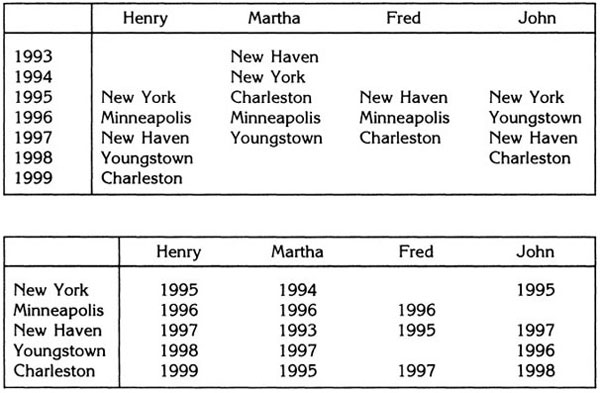
Both tables show that Henry and John were in New Haven in 1997, and that Henry, Martha, and Fred were in Minneapolis in 1996.
On a certain day I ate lunch at Tommy’s, took out 2 books from the library (The Sea Wolf and Martin Eden, both by Jack London), visited the museum, and had a cavity filled. Tommy’s is closed on Wednesday, the library is closed on weekends, the museum is only open Monday, Wednesday, and Friday, and my dentist has office hours Tuesday, Friday, and Saturday. On which day of the week did I do all these things?
On a certain day I ate lunch at Tommy’s, took out 2 books from the library (The Sea Wolf and Martin Eden, both by Jack London), visited the museum, and had a cavity filled. Tommy’s is closed on Wednesday, the library is closed on weekends, the museum is only open Monday, Wednesday, and Friday, and my dentist has office hours Tuesday, Friday, and Saturday. On which day of the week did I do all these things?
Problem Solution
Step 1. Suggestion for beginning the problem: The restrictions on when these activities occurred are stated in the second sentence.
Step 2. Tommy’s is closed on Wednesday …
![]()
Step 3. … the library is closed on weekends …
![]()
Step 4. … the museum is only open Monday, Wednesday, and Friday … This means it is closed the other days.
![]()
Step 5. … and my dentist has office hours Tuesday, Friday, and Saturday. This eliminates Monday.
![]()
Step 6. On which day of the week did I do all these things? Friday.
Boris, Irwin, and Steven are engaged in the occupations of librarian, teacher, and electrician, although not necessarily in that order. The librarian is Steven’s cousin. Irwin lives next door to the electrician. Boris, who knows more facts than the teacher, must drive 45 minutes to visit Irwin’s house.
What is each man’s occupation?
It is helpful to use a table like the one shown below. Here is step 1 in the solution.
Step 1. The problem says the librarian is Steven’s cousin. That means Steven is not the librarian. This is shown by writing “NO” in the table.

Complete the table and determine each man’s occupation.
Boris, Irwin, and Steven are engaged in the occupations of librarian, teacher and electrician, although not necessarily in that order. The librarian is Steven’s cousin. Irwin lives next door to the electrician. Boris, who knows more facts than the teacher, must drive 45 minutes to visit Irwin’s house.
Problem Solution
Step 1. The problem says the librarian is Steven’s cousin. That means Steven is not the librarian. This is shown by writing “NO” in the table.

Step 2. Irwin lives next door to the electrician. This means Irwin is not the electrician.

Step 3. “Boris, who knows more facts than the teacher, …” This means Boris is not the teacher.

Step 4. “… must drive 45 minutes to visit Irwin’s house.”
An earlier sentence said Irwin lives next door to the electrician. Since Boris must drive 45 minutes to visit Irwin, he is not the electrician.

Step 5. From the table we see that Boris must be the librarian.

Step 6. The table also shows that Steven must be the electrician.

Step 7. Irwin must be the teacher.
Problem 12
Three men—Fred, Ed, and Ted—are married to Joan, Sally, and Vickie, but not necessarily in that order. Joan, who is Ed’s sister, lives in Detroit. Fred dislikes animals. Ed weighs more than the man who is married to Vickie. The man married to Sally breeds Siamese cats as a hobby. Fred commutes over 200 hours a year from his home in Ann Arbor to his job in Detroit. Match up the men with the women they married.
Three men—Fred, Ed, and Ted—are married to Joan, Sally and Vickie, but not necessarily in that order. Joan, who is Ed’s sister, lives in Detroit. Fred dislikes animals. Ed weighs more than the man who is married to Vickie. The man married to Sally breeds Siamese cats as a hobby. Fred commutes over 200 hours a year from his home in Ann Arbor to his job in Detroit. Match up the men with the women they married.
Problem Solution
Step 1. The problem says Joan is Ed’s sister. Therefore Joan and Ed are not married.

Step 2. The problem says Joan lives in Detroit, and Fred dislikes animals. There is no way to use that information yet.
The next statement says Ed weighs more than the man who is married to Vickie. That means Ed is not married to Vickie.

Step 3. The table shows that Ed must be married to Sally.

Step 4. Since Ed is married to Sally, we know that neither Fred nor Ted is married to Sally.

Step 5. The problem says that the man married to Sally breeds Siamese cats as a hobby. Earlier the problem said that Fred dislikes animals. That means that Fred is not married to Sally. This is already shown in the table.
Step 6. The problem says that Fred commutes from his home in Ann Arbor to his job in Detroit. Earlier it said Joan lives in Detroit. Therefore we can conclude that Fred is not married to Joan.

Step 7. Fred must be married to Vickie.
Joan must be married to Ted.
Problem 13
You are facing east, you turn to face the opposite direction, and then you turn 90% left. Which direction is now on your left side?
You are facing east, you turn to face the opposite direction, and then you turn 90% left. Which direction is now on your left side?
Problem Solution
Step 1. A useful aid in solving a problem like this in your head (without making a diagram) is to picture yourself standing on some map with which you are familiar. The following solution uses a map of the United States.
Step 2. You are facing east …
On a map of the United States you would be facing the Atlantic Ocean, with Canada on your left and the southern states such as Florida and Texas on your right.
Step 3. … you turn to face the opposite direction …
You might turn left, past Canada, and face California.
Step 4. … and then you turn left 90%.
You turn south facing Texas.
Step 5. Which direction is now on your left side?
If you are facing south, the east coast is on your left.
East is on your left.
A train left city A at 9:35 and arrived at city B 5 hours and 40 minutes later. What time did it arrive at city B?
A train left city A at 9:35 and arrived at city B 5 hours and 40 minutes later. What time did it arrive at city B?
Problem Solution
Step 1. 9:35 plus 3 hours is 12:35.
Step 2. 12:35 plus 2 more hours is 2:35.
Step 3. 2:35 plus 40 minutes is 2:75.
Step 4. 2:75 is 3:15. (Since there are 60 minutes in 1 hour.) The train arrived at 3:15.
Belvedere Street is parallel to St. Anthony Street. Davidson Street is perpendicular to River Street. River Street is parallel to St. Anthony Street. Is Davidson Street parallel or perpendicular to Belvedere?
Belvedere Street is parallel to St. Anthony Street. Davidson Street is perpendicular to River Street. River Street is parallel to St. Anthony Street. Is Davidson Street parallel or perpendicular to Belvedere?
Problem Solution
Step 1. Belvedere Street is parallel to St. Anthony Street.

Step 2. Davidson Street is perpendicular to River Street.
This sentence presents information on two new streets. It can be skipped over temporarily.
Step 3. River Street is parallel to St. Anthony Street.
This can be added to the above diagram.
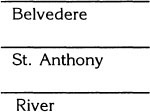
Step 4. Now, going back to the second sentence: Davidson Street is perpendicular to River Street.
This can now be added to the diagram.

Step 5. Is Davidson Street parallel or perpendicular to Belvedere?
The diagram shows that Davidson is perpendicular.
In the town of Pottsville, streets with names that begin with a vowel and end with a consonant run north-south. Those which begin with a consonant and end with a vowel run east-west. Others may run either way. If Carter Street is perpendicular to Agnes Street, is it parallel or perpendicular to Sheridan Street, which runs north-south?
In the town of Pottsville, streets with names that begin with a vowel and end with a consonant run north-south. Those which begin with a consonant and end with a vowel run east-west. Others may run either way. If Carter Street is perpendicular to Agnes Street, is it parallel or perpendicular to Sheridan Street, which runs north-south?
Problem Solution
Step 1. The question concerns the relationship between Carter and Sheridan.
Step 2. Sheridan runs north-south.
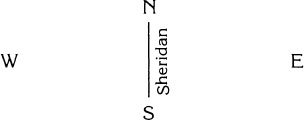
Step 3. Carter begins with a consonant and ends with a consonant so it can run either way.
Step 4. Agnes begins with a vowel and ends with a consonant so it runs north-south.
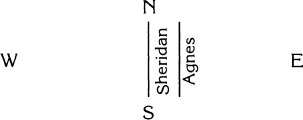
Step 5. The problem says Carter is perpendicular to Agnes.

Step 6. The diagram shows that Carter Street is perpendicular to Sheridan.
How many letters are in either the rectangle or the square, but not in both?
Note: The problem says nothing about the circle. Therefore treat the circle as if were not there. A simple example illustrates this idea. If an instructor asked all blue-eyed students to stand up, it would mean both tall and short blue-eyed students. Since height is not mentioned, it should be ignored in this situation.

How many letters are in either the rectangle or the square, but not in both?

Problem Solution
A is in just the rectangle.
C is in just the square.
D is in just the square.
G is in just the square (ignoring the circle).
F is in just the square (ignoring the circle).
I is in just the rectangle (ignoring the circle).
K is in just the rectangle.
There are 7 letters in either the rectangle or the square, but not in both.
In working this problem, consider the diagram to be made up of 3 major geometrical figures. 1. a triangle; 2. a circle; and 3. a rectangle. How many letters are in exactly 2 (but not 3) of these figures?
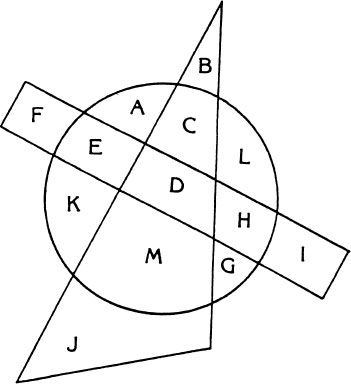
In working this problem, consider the diagram to be made up of 3 major geometrical figures: 1. a triangle; 2. a circle; and 3. a rectangle. How many letters are in exactly 2 (but not 3) of these figures?
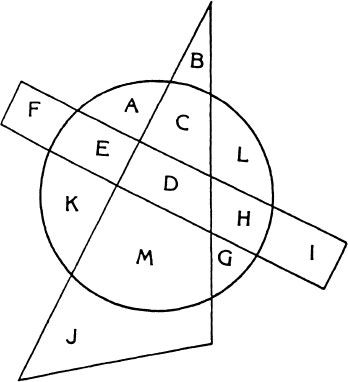
Problem Solution
E is in the circle and the rectangle.
C is in the triangle and the circle.
H is in the circle and the rectangle.
M is in the circle and the triangle.
There are 4 letters in exactly 2 figures.
In working this problem, consider the diagram to be made up of 5 major geometrical figures: 1. 1 triangle; 2. 2 circles; and 3. 2 rectangles. List the letters which are in the same number of major geometrical figures as the letter G. List them here ___________.
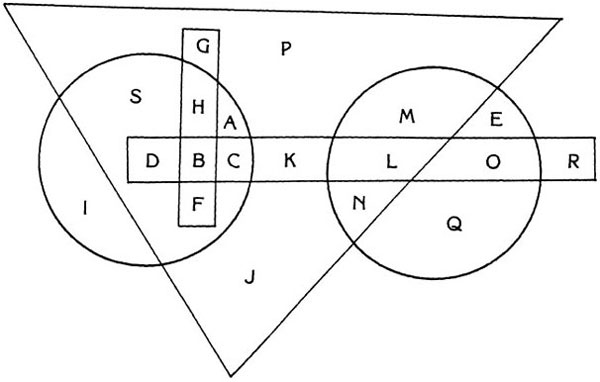
In working this problem, consider the diagram to be made up of 5 major geometrical figures: 1. 1 triangle; 2. 2 circles; and 3. 2 rectangles. List the letters which are in the same number of major geometrical figures as the letter G. List them here ___________.
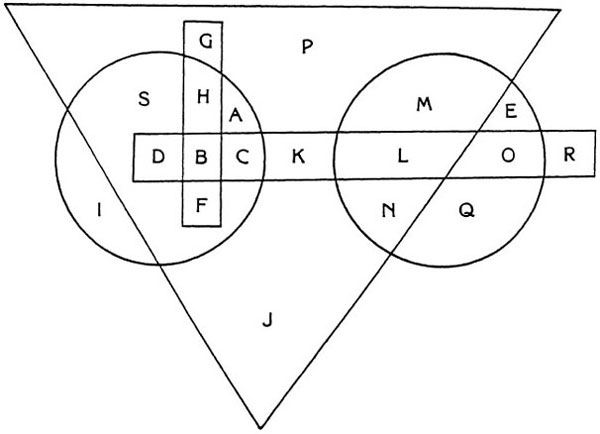
Problem Solution
Step 1. The letter G is in the triangle and also in 1 of the rectangles. So it is in 2 major geometrical figures.
Step 2. S is in the triangle and 1 of the circles.
A is in the triangle and 1 of the circles.
K is in the triangle and 1 of the rectangles.
N is in the triangle and 1 of the circles.
M is in the triangle and 1 of the circles.
O is in 1 of the rectangles and 1 of the circles.
The next group of problems employ Venn diagrams. Here is the way Venn diagrams can be used to represent certain statements.
Example a. All A are B. (For instance, all dogs are animals.)
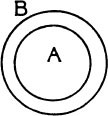
Example b. No C are D. (For instance, no people are cars.)

Example c. Some E are F. (For instance, some women are Democrats.)

Problem 20
Problem: |
Make a Venn diagram with 3 circles showing the following relationships. |
Some x are y. No x are z. No y are z. |
Make a Venn diagram with 3 circles showing the following relationships.
Some x are y. No x are z. No y are z.
Problem Solution

Make a Venn diagram with 3 circles showing the following relationships.
Some x are y. Some x are z. No y are z.
Make a Venn diagram with 3 circles showing the following relationships.
Some x are y. Some x are z. No y are z.
Problem Solution

Make a Venn diagram showing the relationships between cats, animals, and cars, using one circle to represent cats, another to represent animals, and a third to represent cars.
Make a Venn diagram showing the relationships between cats, animals, and cars, using one circle to represent cats, another to represent animals, and a third to represent cars.
Problem Solution

Make a Venn diagram showing the relationships between cats, dogs, and animals.
Make a Venn diagram showing the relationships between cats, dogs, and animals.
Problem Solution
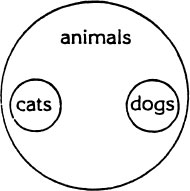
If some of Totteville’s residents have brown eyes and some of Totteville’s residents are women, is the statement “Some of Totteville’s residents are brown-eyed women” true, false, or unsubstantiated?
If some of Totteville’s residents have brown eyes and some of Totteville’s residents are women, is the statement “Some of Totteville’s residents are brown-eyed women” true, false, or unsubstantiated?
Problem Solution
From the statement we can’t tell whether none of the brown-eyed residents are women (as shown in diagram 1) or whether some of the brown-eyed residents are women (as shown in diagram 2).
Therefore the statement is not definitely false (diagram 1) or definitely true (diagram 2). It is just unsubstantiated.
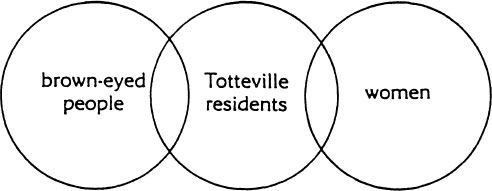
Diagram 1
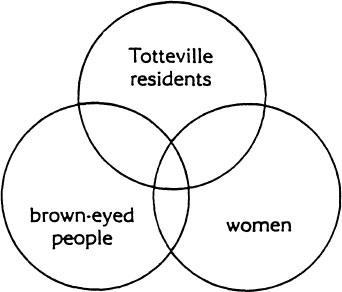
Diagram 2
For this problem, assume the first two statements are correct and make a diagram to represent the relationships.1 Then answer the questions.
All bears are butterflies. All bees are bears.
a. Can you be certain that all bees are butterflies?
b. Can you be certain that all butterflies are bees?
For this problem, assume the first two statements are correct and make a diagram to represent the relationships. Then answer the questions.
All bears are butterflies. All bees are bears.
a. Can you be certain that all bees are butterflies?
b. Can you be certain that all butterflies are bees?
Problem Solution
Here is the diagram showing that all bees are bears and all bears are butterflies.
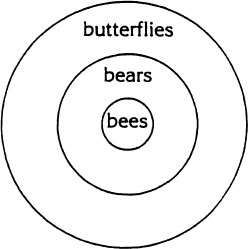
Answer for question a. |
The diagram shows that all bees are butterflies. Anything in the circle for bees is automatically in the circle for butterflies. |
Answer for question b. |
The diagram shows that there can be butterflies which are not bees. For example, the dot in the diagram below is a butterfly that is not a bee. |
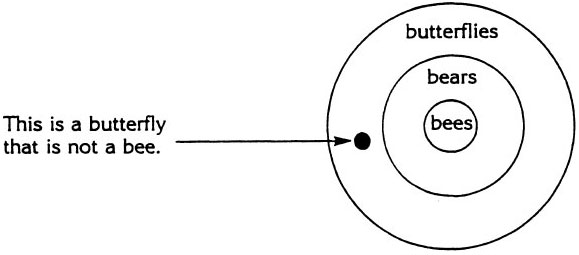
The fire department wants to send booklets on fire hazards to all teachers and homeowners in town. How many booklets does it need, using these statistics? Use a Venn diagram in solving this problem.
Homeowners |
50,000 |
Teachers |
4,000 |
Teachers who own their homes |
3,000 |
The fire department wants to send booklets on fire hazards to all teachers and homeowners in town. How many booklets does it need, using these statistics?
Homeowners |
50,000 |
Teachers |
4,000 |
Teachers who own their homes |
3,000 |
Problem Solution
Step 1. The left circle is the homeowners. The right circle is the teachers.
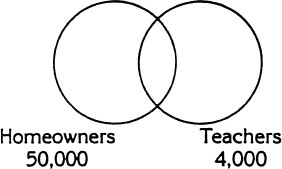
Step 2. Three thousand people are both homeowners and teachers.

Step 3. The remaining portions of the circles can be filled in.
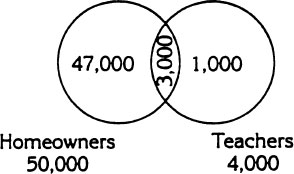
Step 4. The total booklets needed is: 
An insurance company wants to contact all physicians and all licensed drivers in town. Using these statistics, how many people must be contacted? Draw a Venn diagram with your solution.
Licensed drivers |
8,000 |
Physicians |
750 |
Physicians with drivers licenses |
750 |
An insurance company wants to contact all physicians and all licensed drivers in town. Using these statistics, how many people must be contacted?
Licensed drivers |
8,000 |
Physicians |
750 |
Physicians with drivers licenses |
750 |
Problem Solution
Step 1. Seven hundred and fifty licensed drivers are physicians.
Licensed drivers 8,000, Physicians 750
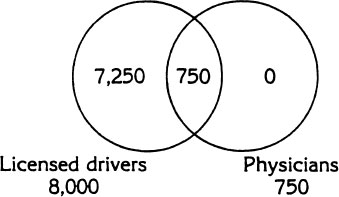
Step 2. 8,000 people need to be contacted.
The government wants to contact all druggists, all gun store owners, and all parents in a town. How many people must be contacted, using these statistics?
Druggists |
10 |
Gun store owners |
5 |
Parents |
3,000 |
Druggists who own gun stores |
0 |
Druggists who are parents |
7 |
Gun store owners who are parents |
3 |
Hint: Use this Venn diagram. Note that since no druggists own gun stores, two sections have zeroes.
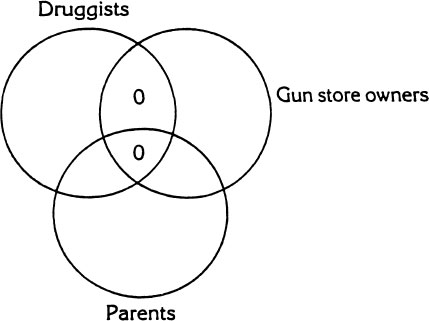
The government wants to contact all druggists, all gun store owners, and all parents in a town. How many people must be contacted, using these statistics?
Druggists |
10 |
Gun store owners |
5 |
Parents |
3,000 |
Druggists who own gun stores |
0 |
Druggists who are parents |
7 |
Gun store owners who are parents |
3 |
Problem Solution
Step 1. The diagram shows the number of people in each category.
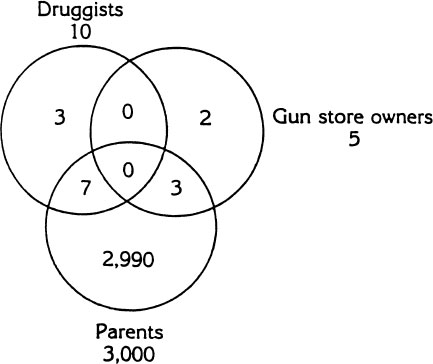
Step 2. The total number that must be contacted is: 
If deleting the letters B, R, and A from the word burglary leaves a meaningful 3-letter word, circle the first R in this word burglary. Otherwise circle the U in the word burglary where the word appears for the third time in the exercise.
If deleting the letters B, R, and A from the word burglary leaves a meaningful 3-letter word, circle the first R in this word burglary. Otherwise circle the U in the word b![]() rglary where the word appears for the third time in the exercise.
rglary where the word appears for the third time in the exercise.
Problem Solution
Step 1. If deleting the letters B, R, and A from the word burglary …
burglary
Step 2. … leaves a meaningful 3-letter word …
No. The word which remains is ugly, and it has four letters.
Step 3. … circle the first R in this word burglary.
So this should not be done.
Step 4. Otherwise circle the U in the word burglary where the word appears for the third time in the exercise.
The word burglary occurs for the third time in the last sentence of the problem. The U has been circled on the original problem above.
Indicate the position of the letter in the word enrage which is the seventh letter in the alphabet.
a. First
b. Second
c. Third
d. Fourth
e. Fifth
f. Sixth
g. Seventh
h. Eighth
Indicate the position of the letter in the word enrage which is the seventh letter in the alphabet.
a. First
b. Second
c. Third
d. Fourth
e. ![]()
f. Sixth
g. Seventh
h. Eighth
Problem Solution
Step 1. The seventh letter in the alphabet is: A B C D E F G.
Step 2. The letter G is the fifth letter in the word enrage: ![]() .
.
Step 3. The word fifth is circled above.
What number is twice the distance below 20 as 7 is above 4? Circle your answer below.
![]()
What number is twice the distance below 20 as 7 is above 4? Circle your answer below.
![]()
Problem Solution
Step 1. The distance that 7 is from 4 is: 7 − 4 = 3.
Step 2. Twice this distance is: 2 × 3 = 6.
Step 3. The number that is 6 below 20 is: 20 − 6 = 14.
The number 14 is circled in the original problem above.
If the fourth number is greater than the second number, circle the third number unless the third number is greater than the fifth number. In this case, circle the number which is the difference between the second number and the seventh number.
![]()
If the fourth number is greater than the second number, circle the third number unless the third number is greater than the fifth number. In this case, circle the number which is the difference between the second number and the seventh number.
![]()
Problem Solution
Step 1. If the fourth number is greater than the second number …
The fourth number is 5. The second number is 4. So the fourth number is greater than the second number.
Step 2. … circle the third number unless the third number is greater than the fifth number.
The third number is 6. The fifth number is 2. So the third number is greater than the fifth number and, therefore, it should not be circled.
Step 3. In this case, circle the number which is the difference between the second number and the seventh number.
The second number is 4. The seventh number is 9. The difference between 9 and 4 is 5. Therefore the 5 has been circled on the original problem above.
If the difference between the second and the fourth numbers is greater than the difference between the third and the fifth numbers, circle the seventh number. Otherwise, obtain the difference between the differences and circle it.
![]()
If the difference between the second and the fourth numbers is greater than the difference between the third and the fifth numbers, circle the seventh number. Otherwise, obtain the difference between the differences and circle it.
![]()
Problem Solution
Step 1. If the difference between the second and the fourth number …
The second number is 3. The fourth number is 6. The difference is 3.
Step 2. … is greater than the difference between the third and fifth numbers …
The third number is 4. The fifth number is 9. The difference is 5.
Therefore, the difference between the second and fourth numbers is not greater than the difference between the third and the fifth number.
Step 3. … circle the seventh number.
This should not be done.
Step 4. Otherwise, obtain the difference between the differences and circle it.
The 2 differences are 3 and 5. The difference between these two numbers is 2. Therefore, the difference between the differences is 2.
The 2 has been circled on the original problem above.
Circle the letter in the name Anthony which is 3 letters before the letter that follows the middle letter of the name.
Circle the letter in the name A![]() thony which is 3 letters before the letter that follows the middle letter of the name.
thony which is 3 letters before the letter that follows the middle letter of the name.
Problem Solution
Step 1. The middle letter in Anthony is H: Anthony.
Step 2. The letter which follows H is O: Anthony.
Step 3. The letter which is 3 letters before O is N: Anthony.
Therefore N has been circled on the original problem above.
Cross out the letter in the word participate which is 2 letters before the second T.
Cross out the letter in the word partici![]() ate which is 2 letters before the second T.
ate which is 2 letters before the second T.
Problem Solution
Step 1. The second T in participate is the one next to the E: participate.
Step 2. Two letters before this T is P: participate.
This P has been crossed out on the original problem above.
Problem 36 A Problem in Code Breaking
In a foreign language lev klula buj means “buy green peppers.” However, words in this tongue are not always spoken in the same order as in English. For example, buj does not mean “peppers.” Also, ajm buj gyst means “big green cars” and lkuka lev ajm means “quickly buy cars.” How would you say big peppers in this tongue?
Hint: Write all 3 foreign phrases with their English translations next to them, then compare the phrases to see the words they have in common.
a. buj klula
b. klula buj
c. klula gyst
d. lev gyst
e. lkuka ajm
In a foreign language lev klula buj means “buy green peppers.” However, words in this tongue are not always spoken in the same order as in English. For example, buj does not mean “peppers.” Also, ajm buj gyst means “big green cars” and lkuka lev ajm means “quickly buy cars.” How would you say big peppers in this tongue?
Hint: Write all 3 foreign phrases with their English translations next to them, then compare the phrases to see the words they have in common.
a. buj klula
b. klula buj
c. klula gyst
d. lev gyst
e. lkuka ajm
Problem Solution
Step 1. Three phrases are given in both the foreign tongue and English. These are:
(1) lev klula buj—“buy green peppers”
(2) ajm buj gyst—“big green cars”
(3) lkuka lev ajm—“quickly buy cars”
Step 2. The foreign word (1) and (2) have in common is buj; the English word they have in common is green. So buj must mean green.
Step 3. Apparently the foreign tongue has a different grammar than English since green is the second word in both (1) and (2), but buj is not the second word in (1) and (2).
Step 4. The foreign word that (1) and (3) have in common is lev; the English word they have in common is buy. So lev must mean buy.
Step 5. The foreign word that (2) and (3) have in common is ajm; the English word they have in common is cars. So ajm must mean cars.
Step 6. The problem asks for the translation of “big peppers.” The 3 words which have already been translated are:
![]()
Step 7. The word peppers is contained in (1). Since lev and buj are already known to be buy and green, klula must be peppers.
Step 8. The word big is contained in (2). Since buj and ajm are already known to be green and cars, gyst must be big.
![]()
Step 9. Therefore, “big peppers” must have the words klula and gyst. This is answer c.
In a different language luk eir lail means “heavy little package,” bo lail means “heavy man,” and luk jo means “pretty package.” How would you say “little man” in this language?
In a different language luk eir lail means “heavy little package,” bo lail means “heavy man,” and luk jo means “pretty package.” How would you say “little man” in this language?
Problem Solution
Step 1. Luk eir lail means “heavy little package;” bo lail means “heavy man.”
The foreign word the 2 phrases have in common is lail; the English word they have in common is heavy. So apparently lail means heavy.
Step 2. The phrase bo lail means “heavy man,” and since lail means heavy, bo must mean man.
Step 3. Luk eir lail means “heavy little package;” luk jo means “pretty package.”
The foreign word they have in common is luk; the English word they have in common is package. So luk must mean package.
Step 4. Luk eir lail means “heavy little package.” Since luk means package, and lail means heavy, eir must mean little.
Step 5. How would you say “little man” in this language?
It has been determined that: Bo means man; Eir means little.
Step 6. The foreign language apparently expresses certain ideas in the reverse order of English—adjectives follow nouns.
Therefore, “little man” is: bo eir.
José owes Som $27.00. Som owes Fred $6.00 and Albert $15.30. If, with Som’s permission, José pays off Som’s debt to Albert, how much does he still owe Som?
José owes Som $27.00. Som owes Fred $6.00 and Albert $15.30. If, with Som’s permission, José pays off Som’s debt to Albert, how much does he still owe Som?
Problem Solution
Step 1. The diagram below shows who owes whom money. The arrows point in the direction in which the money is owed.

Step 2. José pays off Som’s debt to Albert, so this is subtracted from the amount he owes Som.

Step 3. José still owes Som $11.70.
Sally loaned $7.00 to Betty. But Sally borrowed $15.00 from Estella and $32.00 from Joan. Moreover, Joan owes $3.00 to Estella and $7.00 to Betty. One day the women got together at Betty’s house to straighten out their accounts. Which woman left with $18.00 more than she came with?
Hint: On your diagram, use arrows to show which person has to return money to which other person. Show the direction in which the money must be returned.
Sally loaned $7.00 to Betty. But Sally borrowed $15.00 from Estella and $32.00 from Joan. Moreover, Joan owes $3.00 to Estella and $7.00 to Betty. One day the women got together at Betty’s house to straighten out their accounts. Which woman left with $18.00 more than she came with?
Problem Solution
Step 1. The problem began “Sally loaned $7.00 to Betty.” This is shown below with the arrow indicating the direction to which the money must be returned.
![]()
Step 2. The entire pattern of debts is shown in the following diagram.

Step 3. Which girl left with $18.00 more than she came with?
The diagram shows that Estella received $3.00 from Joan and $15.00 from Sally, for a total of $18.00.
Estella left with $18.00 more than she came with.
Lester has 12 times as many marbles as Kathy. John has half as many as Judy. Judy has half as many as Lester. Kathy has 6 marbles. How many marbles each do Lester and John have? You do not need to use algebra to solve this problem.
Lester has 12 times as many marbles as Kathy. John has half as many as Judy. Judy has half as many as Lester. Kathy has 6 marbles. How many marbles each do Lester and John have?
Problem Solution
Step 1. Kathy has 6 marbles.
Step 2. Lester has 12 times as many marbles as Kathy. So Lester has 72 (12 − 6) marbles.
In mathematical shorthand this can be written:

Step 3. Judy has half as many as Lester. So Judy has ![]() of 72 = 36.
of 72 = 36.
This can be written:

Step 4. John has half as many as Judy. So John has ![]() of 36 = 18.
of 36 = 18.
Step 5. Lester has 72 marbles; John has 18.
1. Betty is shorter than Sally. Cynthia is taller than Sally. Carla is shorter than Betty. Is Sally shorter or taller than Carla?
2. John is faster than Pete. Dave is faster than Harvey. Dave is slower than Pete. Which man is fastest and which is slowest?
3. If Bob and Fred are both taller than Tom, while Hal is taller than Bob but shorter than Fred, which man is tallest and which is second tallest?
4. Gladys is a teacher, Sally a truck driver, Violet a crane operator, and Hannah a Hollywood stuntwoman. The truck driver is heavier than Hannah. The crane operator is lighter than the stuntwoman. Gladys is heavier than the truck driver. Which woman is heaviest and which is lightest?
5. Dracula hates daylight more than Wolfman unless Frankenstein hates daylight more than Dracula. In that case Wolfman hates daylight more than Dracula but less than Mummy. Mummy hates daylight more than Dracula but less than Frankenstein. Show a diagram of the monsters ordered according to their hatred of daylight.
6. A graph breaking down the cost of education for the state showed that the category labeled “operation, maintenance, and auxiliary agencies” took a greater portion of the budget than “capital outlay.” The category labeled “instruction” had the highest portion of the budget, while “interest” had a smaller portion than “capital outlay” and “general control” had a smaller portion than “interest.” Show a diagram of the categories ordered according to their portion of the budget.
7. The Great Lakes differ in both their areas (measured in square miles) and their depths. However these two dimensions do not keep step perfectly. For example, Lake Michigan is exceeded in depth only by Lake Superior, but it is exceeded in area by both Lakes Superior and Huron. Lake Superior is by far the largest and deepest of the Great Lakes, but Lake Ontario, which is the smallest in area, is deeper than both Lakes Huron and Erie. Lake Erie is larger than Lake Ontario but it is not only shallower than Huron, it is also shallower than Ontario. Show the order of the Great Lakes according to depth.
8. Bob, Juanita, Ted, and Aretha together have a total income of $1,100 a week, of which $210 is made by Bob. Bob and Juanita together make $500 a week, while Bob and Ted together make $530. How much do Juanita and Aretha make together?
9. Three women—Pat, Joan, and Mary—have between them a total of 30 dresses of which 15 are cotton and the rest are either wool or synthetic fibre. Pat has 3 cotton dresses and 3 synthetics. Mary, who has a total of 8 dresses, has 4 cotton dresses. Pat has the same number of wool dresses as Mary has cotton dresses. Joan has as many wool dresses as Pat has cotton dresses. And Mary also has as many wool dresses as Pat has cotton dresses. How many total dresses does Joan have? (Show the table completely filled in.)
10. Four lawn care fanatics, Fred, John, Alice, and Nina between them own 86 grass cutting devices consisting of shears, string trimmers, and power mowers. Fred likes to be close to his work, so he owns 8 shears and 13 string trimmers, but no mower. John is just the opposite. He prefers to stay as far from the work as possible and therefore owns only power mowers, 33 in all! Alice is an all-around gardener who owns 5 shears, 8 power mowers, and various string trimmers. Nina, a woman of many talents, has a total of 15 implements, among which are 3 shears and 5 string trimmers. Interestingly, the four fanatics own more than twice as many mowers as string trimmers, 48 mowers in all. How many string trimmers does Alice own?
11. In this problem the “first quarter of the year” means January, February, and March. The “second quarter” is April, May, and June, and so on.
Acme Realtors sold 23 houses during the first quarter of the year and again during the last quarter. Sales during the middle two quarters were not quite as good, so that the annual sales total was 57 houses. B & B Realty company sold 50 houses during the second quarter and half that many during the fourth quarter, for a total annual sales of 75 houses. Arco sold as many houses during the third quarter as B & B sold during the entire year, but during the other three quarters they did no better than B & B during the first quarter. Together the three companies sold 79 houses during the third quarter. How many total houses did the three companies sell during the second quarter?
12. John, Harry, and Phil are married to Sally, Nancy, and Arlene, but not necessarily in that order. John, who is Sally’s brother, has five children. Nancy, who is a certified public accountant, wants to wait several years before starting a family. Harry is married to John’s sister. Who is Phil married to?
13. Judy, Celia, and Betty are a math teacher, a truck driver, and a housewife, but not necessarily in that order. Judy can’t drive and is married to the brother of the math teacher. Celia is the best friend of the truck driver. Betty had a bad experience with math in grade school and has avoided all contact with math since then. What is each woman’s occupation?
14. At Ajax Plastics the shipping clerk, the stockgirl, the saleswoman, and the cashier are Rose, Hannah, Geraldine, and Mary Jo, but Mr. Bigwig, the president of Ajax, can’t remember who is which. Bigwig does, however, know these facts: Hannah likes both the saleswoman and the cashier; Mary Jo rides to work with the saleswoman and the cashier; the shipping clerk comes to work alone; Rose is slightly jealous of the cashier. Match up the women with their occupations.
15. You are facing south. You turn left, make an about-face, turn right, and turn right again. Which direction is behind you?
16. You are facing northeast and make an about-face. Which direction is on your right?
17. A man went to bed at 10:25 P.M. and arose at 4:10 A.M. How long was he in bed?
18. In Boontown streets that begin with a vowel run east-west unless they also end in a vowel in which case they run north-south. Other streets can go either way. Berkeley street is perpendicular to Alice street. In which direction does Berkeley run?
19. In a city known as the Big Carrot, streets that begin with a vowel and end with a consonant run east-west while those that begin with a consonant and end with a vowel run north-south. Other streets can go either way. A car driving north makes a left turn. Is it now traveling parallel or perpendicular to Eric Street?
20. There is a car traveling north in the Big Carrot, the city described in problem 19. Is the car traveling parallel or perpendicular to Washington Street which is perpendicular to Rose Street?
21. Make a Venn diagram with 3 circles showing these relationships.
All x are y. Some y are z. No x are z.
22. Make a Venn diagram with 3 circles showing these relationships.
All x are y. Some z are x. Some z are not y. Some z are y but not x.
23. Make a Venn diagram with 4 circles showing these relationships.
All x are y. No y are w. All v are w.
24. Make a Venn diagram showing the relationships among animals, birds, and ducks, using one circle to represent animals, another for birds, and a third for ducks.
25. Make a Venn diagram showing the relationships among animals, brown animals, and dogs, using one circle to represent animals, another for brown animals, and a third for dogs.
26. On Halloween the Big Pumpkin visits the homes of all children, all grandmothers, and all poets in town. How many homes does he visit, using these statistics? Draw a Venn diagram.
Homes with:
Children |
800 |
Grandmothers |
250 |
Poets |
60 |
Children and grandmothers |
100 |
Children and poets |
10 |
Grandmothers and poets |
3 |
Grandmothers and poets and children |
1 |
27. A politician claims that all Catholics and all homeowners in town will vote for him. How many votes does he claim, using these statistics? Draw a Venn diagram.
Catholics |
400 |
Homeowners |
1200 |
Catholic homeowners |
300 |
For the next four problems, assume the first two statements are correct and make a diagram to represent the relationships. Then answer the questions.
28. All crabs are birds. Some birds are blue.
a. Can you be certain that all crabs are blue?
b. Can you be certain that some crabs are blue?
29. Some elephants are lions. All lions have three eyes.
a. Can you be certain that all elephants have three eyes?
b. Can you be certain that some elephants have three eyes?
30. All rifles are automobiles. No automobiles are machines.
a. Can you be certain that some rifles are machines?
b. Can you be certain that no rifles are machines?
31. Some paper is white. No white things are usable things.
a. Can you be certain some paper is usable?
b. Can you be certain that some paper is not usable?
32. Cross out the letter in the word fireplace which is two letters before the letter that precedes the l.
13. If the second half of the second name of our first president contains the second letter in cheese, circle the second word in this sentence. Otherwise, circle the first word in this sentence.
34. If deleting the first, third, fifth, and seventh letters in the word education leaves four more consonants than vowels, circle the first comma in this sentence. Otherwise, circle the second comma.
35. Cross out the letter in the name Jonathan which is two letters after the letter that precedes the h.
36. If the fifth letter in the word sanctuary is the 18th letter in the alphabet, circle it. Otherwise, circle the letter (in the word) which is the fourteenth letter of the alphabet.
37. 8 9 7 5 3 9 9 2 4 6. If the sum of the second and the sixth numbers is greater than 14, circle the third number, unless the sum of the second and the sixth numbers is greater than 15, in which case circle the number which is one-half the last number in the series.
38. 9 8 7 6 5 4 3 2 1. Take the difference between the first number and the sixth number. Write the difference here _____. Now take the difference between the fifth number and the seventh number. Write it here _____. Finally, take the difference between these two differences and write it here _____.
39. 8 2 7 5 6 4 5 3 4. If the difference between the first number and the fifth number is greater than the difference between the first number and the sixth number circle the seven. Otherwise take the difference between the differences and circle it.
40. 1 2 4 7 4 5 3. Subtract the third number from double the fifth number unless double the fourth number is more than the sum of the sixth and seventh numbers; in this case subtract the second number from double the sixth number. Then add two unless the third number is more than the sixth number in which case subtract one. Circle your answer below.
a. 9
b. 5
c. 10
d. 2
e. 7
f. 6
g. 1
h. 11
41. In a foreign language ho lew gi means “buy every dog,” lew ra means “dog food,” and gi trj nk means “every green car.” Which words would you use to say “every food”? (Ignore the order of the words in answering the question.)
42. In a different language si gumba lo means “not very sweet,” ja lo means “not brown,” and ba ja gumba means “very brown coffee.” How would you say “sweet coffee” in this language?
a. lo gumba
b. ja gumba
c. ba si
d. gumba ba
e. ja si
43. In 1968 the Detroit Tigers beat the St. Louis Cardinals in the World Series. Mickey Lolich pitched two winning games for Detroit. In 1946 the Red Sox won the pennant, but were beaten by the Cardinals in the World Series. Country Slaughter was the Cardinals’ hero. Twelve years before that, the Cardinals beat the Tigers in the Series. Dizzy Dean was the pitching hero. Four years before they beat the Red Sox and 8 years after they beat Detroit, the Cardinals beat the New York Yankees. The next year they lost to the Yankees, but the following year they beat the St. Louis Browns, now known as the Baltimore Orioles. Twenty-one years after they beat the Red Sox, they beat them again and 22 years after they beat the Yankees, they beat them again. Eighteen years after this win over the Yankees, the Cardinals took the Series from the Milwaukee Brewers. List the dates of the Series played by the Cardinals, along with the winners and losers. Include the hero or pitching star when one is mentioned.2
Awareness and Communication of Thinking
Now that you have worked a number of problems aloud, you may be more aware of the mental steps you use to solve problems and also better able to explain the steps. Rate your progress on the diagram below.
Awareness

The various exercises in the remaining chapters provide additional opportunities for growing more aware of your thinking activities so you can become a better problem solver and can explain your reasoning to others.
1This question presents an example of assuming something to be true in order to see what relationships and possibilities would result. It is a form of “hypothetical reasoning.” Here we are redefining the common words “bees,” “bears,” and “butterflies” to represent new classes of things having the relationships specified in the first two sentences of the problem. This type of question exercises the mind in that one has to put aside standard knowledge and mentally construct new definitions and relationships in order to solve the problem.
2This problem was contributed by William Hart, Jr., a teacher at Balboa High School in San Francisco. For additional contributed problems see our web site at: www.whimbey.com
